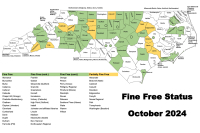Legacy for education: Waynesville couple donates land for natural resource education
 Joe and Sue Morrow live at the bottom of the mountain they recently gave for Haywood Community College’s use as a teaching forest. Holly Kays photo
Joe and Sue Morrow live at the bottom of the mountain they recently gave for Haywood Community College’s use as a teaching forest. Holly Kays photo
Haywood County has seen its share of change over the past century, and nobody knows that better than Joe Morrow.
Morrow, 86, grew up on 107 acres of steep mountain land that today is located just down the road and across from the Haywood County Fairgrounds. It’s been in the family since his grandparents were farming, but he and his wife Sue have now placed 53 acres in a conservation easement that allowed it to become Haywood Community College’s newest teaching forest.
“I believe in education. I believe in helping kids and anything we can do to help them,” said Morrow, who is retired from a long career in education. “I felt like if they needed a laboratory, you can’t learn sitting in a classroom. If you get out in the field, you get some actual experience hands-on, and a two-hour class can put in one-and-a-half hours here easily and be back in time.”
It takes less than 10 minutes to drive from HCC’s campus to the Joe and Sue Morrow Teaching Forest. A gravel road extends about halfway up the mountain, with a trail splitting off to wind around the slope from there. HCC has other teaching forests, but they’re all a much further drive than the 53 acres now available off Crabtree Road.
“One of our forests, it takes a good two hours just to get to the top of the hill,” said Alex Storm, a natural resources instructor at the college. “The way this property is set up, we have very easy access. The roads are great. We can get all over the place very quickly in there. We’ve already used it on a few occasions just in the short time it’s been available to us.”
When the new semester begins in January, instructors will likely start using it even more frequently.
Related Items
“It is wonderful that Joe and Sue Morrow will leave behind such a legacy through this gift,” said HCC President Dr. Barbara Parker. “The forest will significantly impact our students and the community forever. We sincerely thank them.”
The property is protected by a conservation easement held by the Haywood County Soil and Water Conservation District. The easement prevents the land from succumbing to development but offers plenty of latitude for students to experience the kind of hands-on education the Morrows wanted to give.
If the students are learning about how to fight invasive species, they can actually perform the treatments needed to get rid of the undesirable plants. If they’re learning about how to promote the growth of oaks or maintain meadow and edge habitats, they can perform the plantings or cuttings needed to achieve that goal.
“We can manipulate the conditions to make the trees that we want to be growing grow there, and then we can follow those trees,” said Storm. “The students who are doing that work can have that legacy and maybe go back there in 10 or 15 years and see what the result was of their hard work.”
It’s not just forestry students who will benefit from the teaching forest. Ornithology classes can travel there to practice their bird identification skills. Wildlife students can write and carry out wildlife management plans there.
The possibilities are many, especially due to the property’s diversity. It includes old stands of oaks, young forests growing on top of old cattle pasture, coves fostering stands of poplar and dry ridges home to a whole different type of plant community. The land also features several species that aren’t often found growing naturally in Western North Carolina, such as black walnut and red cedar. These trees prefer alkaline soils instead of the acidic ones that more often occur in the mountains.
Of the 53 acres included in the teaching forest, about 40 have never been cut, or at least not in Morrow’s memory. However, the remaining 10 to 15 were once cleared of trees, all the way up to the top of the mountain.
“Of course we tried to farm it,” said Morrow. “Kind of scratched out a living on it — a partial living.”

The Joe and Sue Morrow Teaching Forest includes a diversity of species and plant communities for students to explore. Holly Kays photo
The Morrows pastured cattle on the land, and steep as it was they grew corn as well. Back in the 1930s and ‘40s, they worked the land with horses, not tractors. After World War II, Morrow said, he begged his dad to get a tractor, but no tractor appeared until after Morrow left home.
“When I went to school he finally found out he needed a tractor,” Morrow recalled. “I’d had the hillside plowed with horses and doing all of it.”
The new technology didn’t come easily to his dad, however. Morrow remembers the immediate aftermath of the tractor purchase, and how his father almost gave up on the machine.
“I came in, he had the tractor stuck out there in the barn,” said Morrow. “He didn’t know how to drive it. He was about fit to be tied.”
The horses were up near the top of the mountain, grazing. Morrow’s dad told him to get up there and bring the horses down to do the work, saying that he wouldn’t trade two good horses for a field full of tractors.
“I walked down to the barn. I got on the tractor and cranked it up and just backed it out,” said Morrow. “Boy, I thought he was going to kill me then. He said, ‘I told you to get up there and get those horses.’ I said, ‘I got the tractor out.’”
Eventually, though, Morrow’s dad got too old for farming, and his brother didn’t want to continue the tradition. Morrow himself was gone. He graduated from high school in 1951 and joined the U.S. Marine Corps in 1953, uprooting himself from Haywood County for what would turn out to be decades.
After leaving the Marines, Morrow launched a career in education. He spent about eight years as a community college teacher, mostly in Andrews, and then got into administration. After about 9.5 years of that, Morrow decided that he missed working with kids and moved to the K-12 public school system, eventually retiring as assistant superintendent of Cherokee County.
Despite living scores of miles away in Andrews, he and Sue, herself a Waynesville native, kept a close connection to the family land. Together with Morrow’s brother and two sisters, they sold off 40 acres of the original 107 to be subdivided for residential development. Around that time, they made the move back to Haywood County, where they still live in a house located at the bottom of the family land.
“We of course still had the mountain 53 acres up there, and I didn’t want any more houses on that mountain,” said Morrow. “We’ve got enough houses on our mountains around here now.”
So, Morrow bought out his siblings’ share and set about figuring out just what should be done with the land. HCC proved a good fit, and with the easement now in place, the mountain will remain free from houses. Meanwhile, the land will get the care it needs to remain healthy and resilient against the changes and challenges in store for the century to come.









